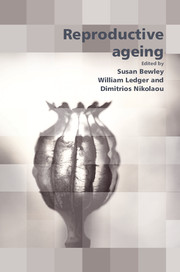Book contents
- Frontmatter
- Contents
- Participants
- Declarations of personal interest
- Preface
- SECTION 1 BACKGROUND TO AGEING AND DEMOGRAPHICS
- SECTION 2 BASIC SCIENCE OF REPRODUCTIVE AGEING
- SECTION 3 PREGNANCY: THE AGEING MOTHER AND MEDICAL NEEDS
- SECTION 4 THE OUTCOMES: CHILDREN AND MOTHERS
- SECTION 5 FUTURE FERTILITY INSURANCE: SCREENING, CRYOPRESERVATION OR EGG DONORS?
- 19 Screening for early ovarian ageing
- 20 Egg freezing: the reality and practicality
- 21 Assisted conception: uses and abuses
- 22 Future fertility insurance
- SECTION 6 SEX BEYOND AND AFTER FERTILITY
- SECTION 7 REPRODUCTIVE AGEING AND THE RCOG: AN INTERNATIONAL COLLEGE
- SECTION 8 FERTILITY TREATMENT: SCIENCE AND REALITY – THE NHS AND THE MARKET
- SECTION 9 THE FUTURE: DREAMS AND WAKING UP
- SECTION 10 CONSENSUS VIEWS
- Index
20 - Egg freezing: the reality and practicality
from SECTION 5 - FUTURE FERTILITY INSURANCE: SCREENING, CRYOPRESERVATION OR EGG DONORS?
Published online by Cambridge University Press: 05 February 2014
- Frontmatter
- Contents
- Participants
- Declarations of personal interest
- Preface
- SECTION 1 BACKGROUND TO AGEING AND DEMOGRAPHICS
- SECTION 2 BASIC SCIENCE OF REPRODUCTIVE AGEING
- SECTION 3 PREGNANCY: THE AGEING MOTHER AND MEDICAL NEEDS
- SECTION 4 THE OUTCOMES: CHILDREN AND MOTHERS
- SECTION 5 FUTURE FERTILITY INSURANCE: SCREENING, CRYOPRESERVATION OR EGG DONORS?
- 19 Screening for early ovarian ageing
- 20 Egg freezing: the reality and practicality
- 21 Assisted conception: uses and abuses
- 22 Future fertility insurance
- SECTION 6 SEX BEYOND AND AFTER FERTILITY
- SECTION 7 REPRODUCTIVE AGEING AND THE RCOG: AN INTERNATIONAL COLLEGE
- SECTION 8 FERTILITY TREATMENT: SCIENCE AND REALITY – THE NHS AND THE MARKET
- SECTION 9 THE FUTURE: DREAMS AND WAKING UP
- SECTION 10 CONSENSUS VIEWS
- Index
Summary
Introduction
In the past three decades, the changing agenda in assisted reproduction, together with the introduction of more restrictive legislation, has increased the interest in oocyte cryopreservation as a means to preserve female fertility. There are many advantages of including oocyte freezing as an adjunct in assisted conception programmes. The indications for oocyte cryopreservation are discussed in Chapter 21.
In summary, when successful, oocyte freezing could be used to improve the efficiency of female fertility treatment in assisted reproduction as it provides an ethically and legally more acceptable long-term storage option for women than embryo freezing. When used as part of an oocyte donation programme, oocyte cryopreservation would remove the need for cycle synchronisation between donor and recipient and it would allow for more effective screening of donors for transmittable diseases such as is currently practised for sperm donors. Oocyte freezing can be used to preserve fertility for women at risk of premature ovarian failure or those with congenital infertility disorders such as Turner syndrome. Finally, oocyte cryopreservation can be used to preserve the germplasm of young women and girls who are likely to lose their fertility as a result or abdominal trauma or ablative cancer treatments.
Despite the great potential of oocyte cryopreservation, historically the success rates of oocyte freezing programmes have lagged behind those of embryo and sperm freezing.
Keywords
- Type
- Chapter
- Information
- Reproductive Ageing , pp. 211 - 226Publisher: Cambridge University PressPrint publication year: 2009

